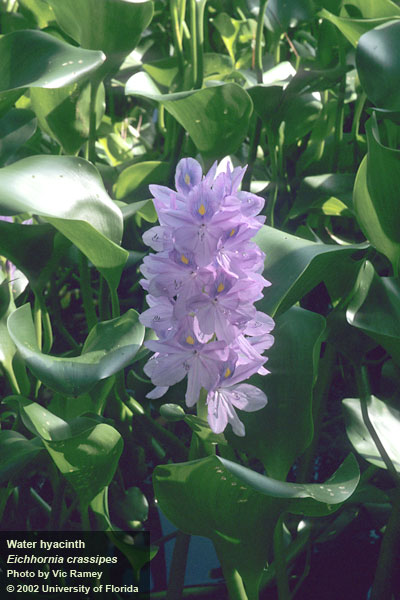EDRR Invasive Species
Water Hyacinth (Eichhornia crassipes)
Define Invasive Species: must have ALL of the following –
- Is non-native to the area, in our case northwest Florida
- Introduced by humans, whether intentional or accidental
- Causing either an environmental or economic problem, possibly both
Define EDRR Species: Early Detection Rapid Response. These are species that are either –
- Not currently in the area, in our case the Six Rivers CISMA, but a potential threat
- In the area but in small numbers and could be eradicated
Native Range:
Water hyacinth is native to South America.
Introduction:
It was introduced intentionally by horticulturists in 1884 at the Cotton States Exposition in New Orleans.
EDDMapS currently list 15,051 records of water hyacinth in the U.S. These records are scattered across the country with over 12,000 coming from the state of California. There are 1,229 reported from the southeastern U.S., which is certainly under reported, and 784 in Florida, also under reported – though resource managers indicate that amount of water hyacinth in Florida has decreased with management efforts. There are 13 records reported from the Six Rivers CISMA. This is assumed to be under reported but suggest the plant is correctly listed as an EDRR species and spread could be stopped. Three are from the Mobile delta area, one from Fairhope AL, and the remaining in Okaloosa County.
Description:
This is a perennial free floating freshwater aquatic plant, with long dark roots. The leaves form rosettes and the petioles can be 12” in length. They are bulbous and inflated, particularly near the base. The leaves are a deep green and glossy looking. They can be six inches wide and elliptic in shape.
The flowers extend above the rosette. They are lavender and blue with a flash of yellow. The flower can be 12” tall and 2” across.
Issues and Impacts:
The plant can form extremely dense floating mats making boating, fishing, or any other water recreation impossible. These dense mats can inhibit the growth of other native plants, reducing certain aquatic animals, and overall decreasing biodiversity. The mats reduce air-water oxygen exchange reducing dissolved oxygen as well as block sunlight reducing the development of many submerged aquatic vegetation. Again, reducing the systems overall biodiversity.
Management:
Small patches in local ponds and lakes can easily be removed by hand.
For large infestations there are large mechanical mowers/choppers that can be used to remove from the waterway. The remains can be further chopped and disposed of.
There are herbicides that can be used but these must be ones approved by both the U.S. EPA and FDACS for use in aquatic systems. The labels will state this. It is illegal to do so otherwise. Care should be taken when selecting herbicides for aquatic use considering other important aquatic plants and toxicity to aquatic animals such as fish. Diquat is considered an excellent choice. Carfentrazone and copper are considered fair. Others are not recommended. NOTE: these herbicides do not always completely eradicate the plant and windy conditions can make treatments a problem. The EDIS publication referenced below is a helpful resource to begin review of chemical treatment, and you can always contact your county extension office for more advice before using aquatic herbicides.
For more information on this EDRR species, contact your local extension office.
References
Water Hyacinth, Eichhornia crassipes
University of Florida IFAS Center for Aquatic and Invasive Plants
https://plants.ifas.ufl.edu/plant-directory/eichhornia-crassipes/
Efficacy of Herbicide Active Ingredients Against Aquatic Weeds.
Enloe, S.F., M.D. Netherland, W. Haller, and K. Langeland.
University of Florida IFAS Electronic Data Information Service (EDIS)
https://edis.ifas.ufl.edu/publication/ag262.
Early Detection and Distribution Mapping System (EDDMapS)
Six Rivers CISMA
https://www.floridainvasives.org/sixrivers/
- Rattlesnakes on Our Barrier Islands; Part 4 – Thermoregulation - December 29, 2025
- Rattlesnakes on Our Barrier Islands; Part 3 – Envenomation - December 22, 2025
- St. Joe Red Tide Claiming Terrapins - December 15, 2025

